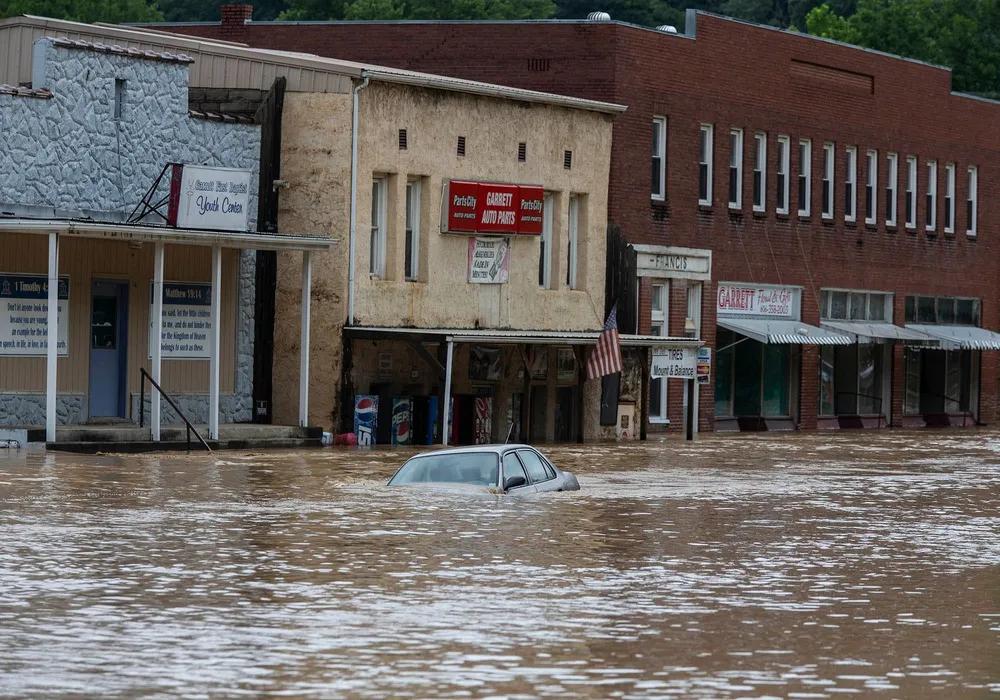The areas of eastern Kentucky hit by record rainfall and devastating floods in July are almost tailor-made for disaster. The area contains steep hillsides and narrow valleys. In some of these, communities are crammed into a tight space that also contains the local river, railroad tracks, a highway, and a few rows of houses. Raise the level of the river, and the water has literally nowhere to go except through those roads, railways, and homes.
Even so, many of these communities have survived generation after generation snuggled down in these narrow valleys without seeing anything like the kind of disaster that swept through the region in 2022. As Weather Underground reported, the floods that struck the region in July crushed all past records. The North Fork Kentucky River, normally barely more than a foot deep, rose by 18 feet in just 10 hours, topping out at a level 9 feet above the base of surrounding homes. At least 39 people died, and more than 700 had to be rescued from rooftops, trees, and instant islands surrounded by raging water.
This flood event came just two days after historic flash flood events in St. Louis and was driven by the same astounding levels of downpour, which saw some areas receive over a foot of rain in just a few hours. The channel of war, hyper-saturated air that drove these record rainfalls is itself exactly the sort of event predicted by climate models for decades. As the air becomes both warmer and wetter, more such events will occur.
But it’s not just the man-made climate crisis that brought dozens of deaths and millions of dollars in destruction to Kentucky. The disaster is also the direct result of exactly the same activity that generated the climate crisis—coal mining for use in power plants.
As the Louisville Courier-Journal reports, it’s not just that eastern Kentucky saw a huge amount of rain falling into areas with steep hills and narrow valleys; it’s that the environment of those valleys had already been devastated by decades of mining.
The combination of contour strip mining and mountaintop removal mining in the area means that hillsides that might otherwise have been covered in large stabilizing vegetation were instead bare, or covered over only by stunted vegetation growing in the wake of half-hearted attempts at post-mining reclamation. Especially in the case of mountain-top removal, the whole structure of the surrounding hills has been transformed. Natural routes of drainage developed over thousands of years have been filled with rubble or choked by silt. Some of these forms of mining are also known as “valley fill” specifically because as the mine removes the top of the mountain, they drop the waste material into the surrounding space.
The result irrevocably alters the surrounding drainage. Water goes into different areas than it did in past decades, flows through even narrower spaces than it did before mining began, moves more rapidly down steeper slopes, and reaches surrounding rivers with more energy due to the lack of protective vegetation.
Everything about the way surface mining takes place in areas like eastern Kentucky makes flooding more likely. Everything about it makes flooding worse.
Over a decade ago, four coal companies operating in the area settled a lawsuit with the state in which they admitted their contribution to flooding in eastern Kentucky. A study of one stream in the region showed that mining on the slopes above had increased peak flows in the stream by 77-81% during a heavy rain. Companies are supposed to reclaim slopes, plant vegetation, and restructure streams so that flows are returned to pre-mining conditions, but a number of ridiculous regulatory rulings—including one boosted by Trump during his first year in office—have allowed companies to dodge these obligations.
Where companies are still obligated to reclaim the land, they often avoid this by the simple method of declaring bankruptcy immediately after the mining is completed. Even in that 2011 lawsuit, two of the four companies had already declared bankruptcy by the time the ruling was handed down. States are supposed to guard against this by demanding an up-front insurance bond that is large enough to cover the cost of post-mining activities, but the truth is that “mining-friendly” states get around this in a number of ways, mostly by allowing companies to be “self-bonding.” That is, self-insuring. The result of this is events like the $100 million bill left behind after a mining company gouged a toxic hole in the Fort Belknap Indian Community in Montana, then declared bankruptcy and walked away.
As the coal mining industry collapses, this kind of story is becoming more and more common. Perversely, Republicans in Congress and state legislators have responded to this growing crisis with calls to “lift the regulatory burden” on mining companies, selling people on the idea that jobs today are all that matter, even though they know that destruction will eventually come in their wake.
And what do you know … it’s eventually.
As the Courier-Journal notes:
This disaster was man made. Strip mining and mountaintop removal reengineered the land and left communities and towns towards the valley floor exposed to record levels of storm runoff. Then the coal companies left and government officials let them offload their bonds tied to abandoned strip mining operations and their promise to clean up their mess. Logging companies also helped, clear cutting hillsides of trees capable of absorbing large amounts of moisture and holding the ground in place and leaving behind fields of kudzu, an invasive plant ill-suited for the job of mountain integrity. Throw in increased greenhouse gas emissions from the global industrialization of the 20th century and you have all the ingredients needed for continued and more frequent catastrophes.
The disaster in eastern Kentucky was generated by increased CO2 in the atmosphere that was the direct result of burning fossil fuels, chiefly coal used in power generation.
The disaster in eastern Kentucky was generated by altered topography and stripped hillsides that are the direct result of surface mining coal through mountaintop removal.
The disaster in eastern Kentucky was generated by regulatory and legislative failures that allowed coal waste to be dumped into streams and for companies to evade their obligation to restore and remediate the damage caused by mining.
The flood waters might have been caused by rain, but there was nothing natural about this disaster.
The flood of July 28, 2022 was not a natural disaster. To imply this flood, along with so many other weather-borne catastrophes plaguing our world, is a natural disaster is to say three things: We don’t know why it happened, we don’t know how it happened and we don’t know how to prevent the next one. But we do know the answers to these questions. We’ve known them for some time. .
The obligation that we owe the people affected by this disaster isn’t just to help them recover and rebuild. It’s also to outlaw the kind of mining that generate this disaster and which is totally unnecessary in a declining market for coal. It’s also to phase out self-bonding and make these companies put up the actual cash necessary to ensure reclamation.
Companies that can’t afford the restore the land can’t afford to mine it. It should be that simple, and not just for coal.
--30--
Written by Mark Sumner of Daily Kos staff. Cross-posted from Daily Kos.







